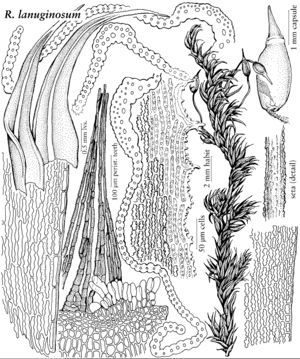Racomitrium
Muscol. Recent., suppl. 4: 78. 1818 ,.
| Taxon | Illustrator ⠉ | |
|---|---|---|
 | Racomitrium lanuginosum | Patricia M. Eckel |
Plants medium-sized to large, coarse and rigid, usually hoary, grayish, brownish or yellowish green, yellow or yellow to blackish brown. Stems mostly pinnately branched, with many short, lateral branchlets. Leaves erect to slightly secund when dry, loosely erect to erect-spreading or spreading-recurved when wet, narrowly ovate to linear-lanceolate; margins 1-stratose, recurved to revolute, entire proximally, coarsely dentate along the hyaline border; apices gradually tapering to a long, slender, hyaline acumen; awns densely papillose, erose-dentate, long-decurrent, with the decurrencies flat or ruffled; costa percurrent, in transverse-section 2-stratose, becoming 3-stratose in the proximal portion; laminal cells 1-stratose, sinuose, dull and opaque, distinctly papillose with large, flat papillae covering the longitudinal walls and almost the whole of the lumina except for a narrow central groove; basal marginal laminal cells long-rectangular, forming 1 (–2) -seriate band, consisting of to 30 rectangular, translucent, not sinuose cells; alar cells not differentiated; medial cells long-rectangular; distal cells short-rectangular. Inner perichaetial leaves hyaline, oblong, oblong-lanceolate to elliptical, abruptly constricted into a short, smooth or weakly papillose awn. Seta single or often 2–3 per perichaetium, sinistrorse when dry, strongly papillose. Capsule straight, ovoid to ovoid-cylindric, somewhat ventricose in the base; annulus revoluble, 2–4-seriate; operculum long-rostrate; peristome teeth, long, reddish-brown, split nearly to the base into 2 filiform, strongly papillose branches. Calyptra conic-mitrate to cucullate, naked. Spores spherical, pale-yellow, finely roughened.
Distribution
North America, Central America, South America, Europe, Asia, South Africa, Atlantic Islands, Indian Ocean Islands, Pacific Islands, Australia, Antarctica
Discussion
Species 3 (1 in the flora).
Traditionally, Racomitrium has been considered as a homogeneous genus characterized by its laminal cells having thick and strongly sinuose to nodulose longitudinal cell walls. This characteristic leaf areolation was typically coupled with a peristome of linear teeth arising from a low or high basal membrane and divided nearly to the base into two filiform, somewhat paired segments that are equally thickened and less prominently trabeculate on both external and internal sides. In addition, the genus was characterized by the consistent lack of a central strand, usual presence of the prostome, sinuose-walled epidermal cells of the vaginula, and cladocarpous sexual condition. This combination of characters made Racomitrium readily recognizable. Revisionary studies of the genus showed that in its traditional circumscription it was an artificial, heterogeneous taxon and, as a result, it has been recently split into four genera, Racomitrium in the narrow sense, Codriophorus, Niphotrichum, and Bucklandiella. Racomitrium in the narrow sense is characterized by: distinctly papillose setae twisted to the left; long, hyaline, strongly papillose awns that are long-decurrent and erose-dentate; large, flat papillae with small secondary papillae densely covering the longitudinal cell walls and almost the whole lumina except for a narrow groove in the middle; peristome teeth divided to the base into 2(–3) filiform branches; and capsules slightly ventricose at the base. The papillosity of the setae is a unique feature of this genus, and is unknown in other acrocarpous mosses. That character, the unusual shape of the awns, and the ventricose capsule make the narrowly conceived Racomitrium readily distinguishable from its segregates.